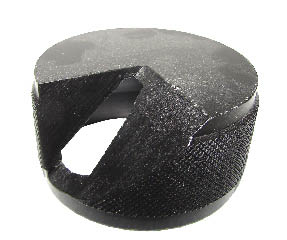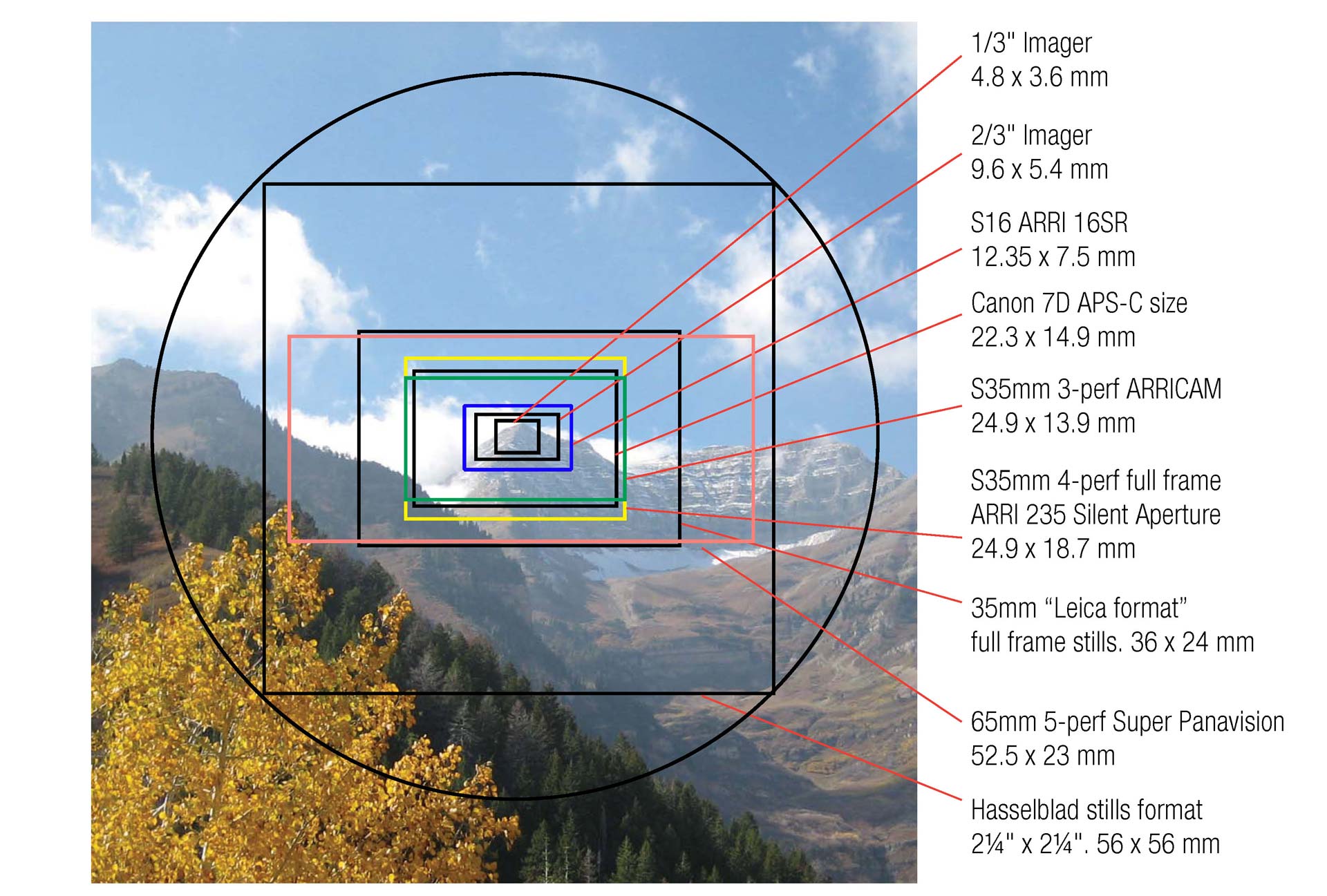Why a 12mm lens is always a 12mm lens
(PDF version of this article is also available here)
This is an update of an FDTimes article from the ancient days of 2007 that tries to clear up some of the mysteries of millimeters. We talk about film cameras a lot because many of the current digital cameras are using specs derived from traditional standards. Other new cameras are venturing into sensor sizes where no one has gone before. Lens manufacturers are scrambling to cover all the various image circles, and not a few productions are scratching their collective heads when the first vignetting images appear in video villages worldwide.
Whether it goes into a 35mm format ARRI, RED, Sony, Vision Research, Weisscam, ViewPlus, Alexa, Epic, F65, Arricam, Moviecam, Arriflex, Aaton, Phantom, or Panavision motion picture camera—it is always a 12mm lens. It’s still a 12mm lens when you mount it on a 16SR, 416, P+S Technik SI-2K, or Aaton 16mm format motion picture camera.
What’s different is the image circle created by the lens on the film or sensor.
Larger imagers require bigger, heavier lenses to cover the entire area.
Once upon a time, things were simpler. Bolex and Beaulieu 16mm lenses had “C” mounts, and you needed adapters to attach 35mm format lenses, most of which had Arri Standard or Bayonet mounts. But PL mounts accept both 35mm and 16mm format lenses.
Look at the lenses at left. They all have PL lens mounts (54mm diameter, with a 52mm flange focal depth).
They all fit into PL lens cavities on both 35mm and 16mm format film and digital cameras.
Careful: many 16mm format lenses extend deeper or wider into the lens cavity and will scratch or break the mirror shutter—so, DO NOT ATTEMPT before checking with a depth tool (below, left).
If we mount the 35mm format Cooke S4/i 12mm (2nd from top) on a 16mm camera, you might break the mirror shutter. If you don’t break it, you’ll have the same angle of view as the 16mm format Cooke SK4 12mm (top).
You’re just carrying around a lot more glass: the 35mm format lenses are larger and they have to cover a larger negative or imager.
Of course, there are other design parameters.
In fact, for the longer focal lengths, Zeiss and Cooke encourage us to use their latest 35mm format lenses on Super16 cameras. From the specs at right, we can see that the manufacturers cover the wide end with specific Super16 format lenses, and leave the long end to the 35mm format lenses.
If we could mount the 16mm format lens (top) on a 35mm camera, what happens? It’s still a 12mm lens. But you would see a round image in the center of the viewfinder because the Super16 format lenses are only designed to cover the diagonal of that format. It vignettes. It doesn’t cover as big an area as 35mm. The diameter of the elements is physically smaller.

ARRI lens tool used to check whether the rear elements of a PL mounted lens will clear the mirror shutter. ARRI part number is ZMISC-PL/JIG. Very good to have. It’s a simple block that slides over the back. The clear opening represents the mirror. It the lens comes through the opening, it will hit the mirror. Photo: George Schmidt
Remember, although the Cooke SK4 6mm, 9.5mm and 12mm are reported to stay clear of a 35mm camera’s mirror shutter, please do this only with caution, careful testing and adult supervision at the rental house whose camera you’re using. The Ultra 16 lenses, identified with a blue band, and most other 16mm format lenses do NOT clear the mirror shutter of 35mm cameras. A replacement mirror shutter costs about $22,000!
Suggestion. Make the following label for your 16mm PL mount lenses: “CAUTION: 16mm FORMAT ONLY.”
Film and Digital Times is not liable for damage caused by the many 16mm lenses that will shatter the shutter and your reputation as a consummate and ever-vigilant camera person.
Angle of view related to different formats is where it gets tricky and we need simple math. The angle of view of the 16mm format lens is about half the angle of view of 35mm format lens. If you want to shoot the same angle, 62 degrees, you’d select a 12mm lens for the 16mm camera and a 24mm lens for your 35mm camera.
Format Sizes
In the photo of Mt. Timpanagos at Sundance, above, the boxes show the aperture area or sensor size for each format. If you placed the camera aperture or negative or groundglass or CCD imager on the picture, each would match the size of the box drawn for that format.
1. Lenses of the same focal length (focused at the same distance), no matter what format they were designed for, make the same size image at the image plane.
If you measured the height of the mountain on the negative from a Hasselblad camera and found it to be 1/8″ (3.2mm) tall, it would also be 1/8″ tall on the 35mm Leica still camera negative, and 1/8″ tall on the Super16 film negative, and 1/8″ tall on the imagers and negatives of all the other formats. Where the format comes into play is that some formats are larger in physical size and some are smaller, thus “cropping” or “seeing” more or less area around the center.
2. Focal length is the distance from the optical center of the lens to the film or digital sensor when the lens is focused at infinity. That’s a simplified definition.
The outer circle, above, defines the actual image that comes out of the back of a Hasselblad lens designed for the 2¼” x 2¼” film format. It’s round because the lens is round. The square 2¼” x 2¼” image aperture lies within that circle.
With some effort, you could build an adapter to put that same Hasselblad lens on cameras of all the other formats. A normal 80mm lens for the Hasselblad remains an 80mm lens for 35mm format and 16mm and so on. But, since a smaller area of film or silicon is exposed for each successively smaller format, a successively narrower angle of view results.
See Mitch Gross’ engrossing video about all this.
Note about Format Size Diagram Above
Format sizes shown here are based on manufacturers specs of apertures and sensor sizes. These vary even from camera to camera within a manufacturers line. For example, an Arricam can be different from an Arri 235.
Super 35 is a very variable size, depending on company and who’s making the groundglass or frame markings. That’s why I will receive emails from Denny Clairmont and Mitch Gross as soon as they read this, because these specs require many footnotes and further explanations. I’ve rounded out the dimenstions to one decimal place for clarity.
Since there are so many aspect ratios and dimensions, lens manufacturers use a diagonal measurement (shown at bottom of page) and try to cover the most area they can.
Math: To calculate comparable angles of view
new lens mm = (new format diagonal / old format diagonal) times old lens mm
If we’re using a 40mm 2/3″ format lens, and want the equivalent 35mm full frame size, here’s the math. New lens comparable angle = (31/11) x 40. That’s because the diagonal of the NEW full 35 film frame is 31mm. The diagonal of the OLD 2/3” CCD is 11mm. The OLD lens is 40mm.
For those of us whose math is rusty: 31 divided by 11 is 2.8. Multiply 2.8 by 40 to get 113. So, the comparable lens angle of the 40mm in 2/3″ format is a 113mm in 35mm format.
Online
There are excellent charts and field of view calculators by Mitch Gross, Andy Shipsides and the team at AbelCine:
• abelcine.com/articles/images/pdf/35mmdigitalsensors_2011.pdf
• Get the Triangulator App from iTunes to calculate diagonals
• For depth of field calculations, I like David Eubank’s pcam calculator iPhone/iPad app
• ARRI formats are found at: fdtimes.com/ howto/index.html
Diagonal measurements of formats
- 1/3″ = 6mm
- 2/3″ chip = 11mm
- Super 16 aperture =14mm
- APS-C (digital still) = 27.3mm
- Standard 35mm motion picture aperture = 28.8mm
- 3-perf 35mm ANSI Super 35 = 28.5mm
- Full frame 35mm cine (silent aperture) = 31.1mm
- RED Epic Mysterium-X = 31.4mm
- Full frame “Leica format” 35mm still camera = 43.3 mm
Credits
With thanks to Bill Bennett, ASC, Jon Maxwell, Chuck Lee, Mitch Gross, Ken Robings, Bill Turner, and Joe Christofori for their great help with this article.












